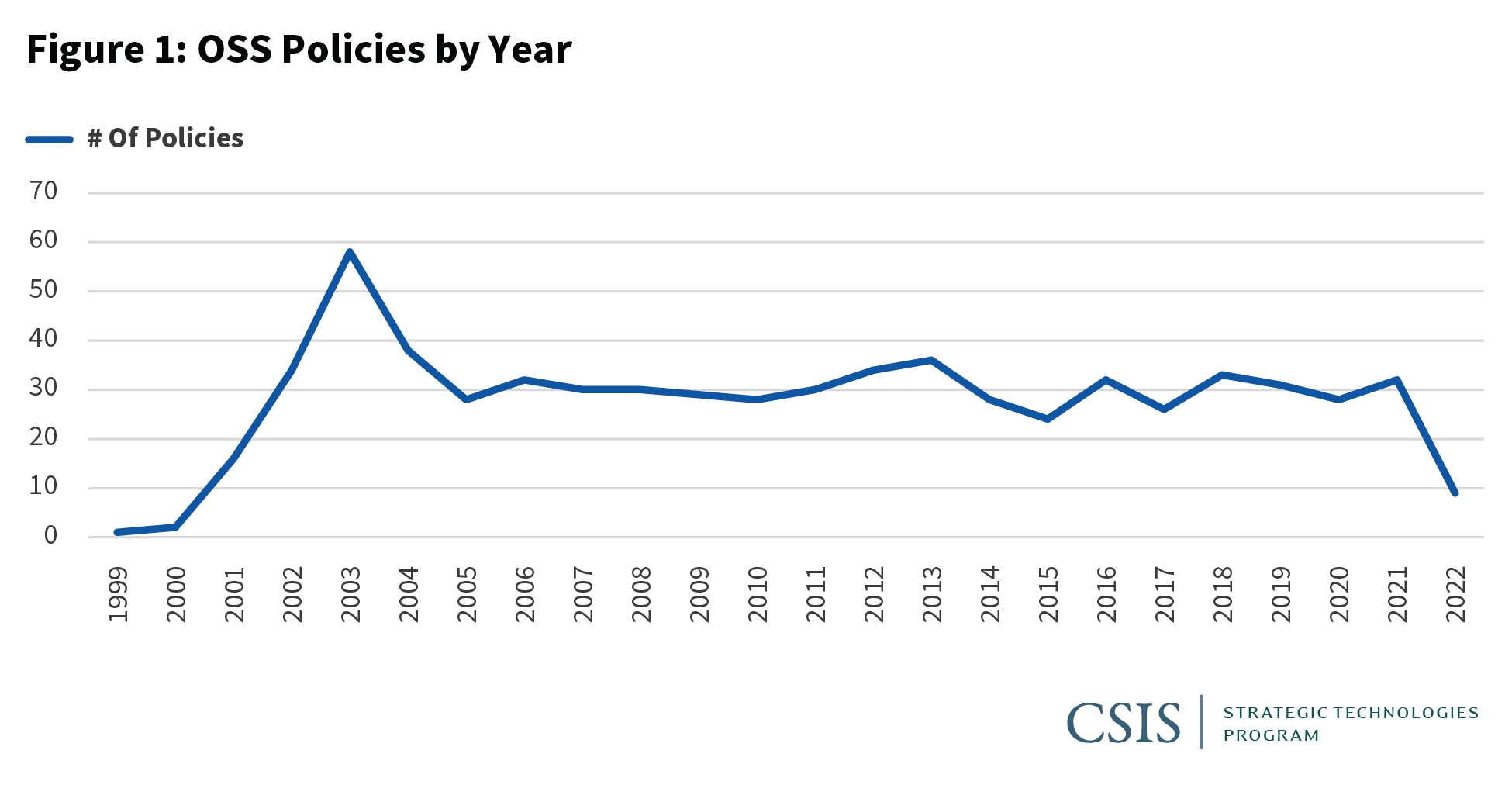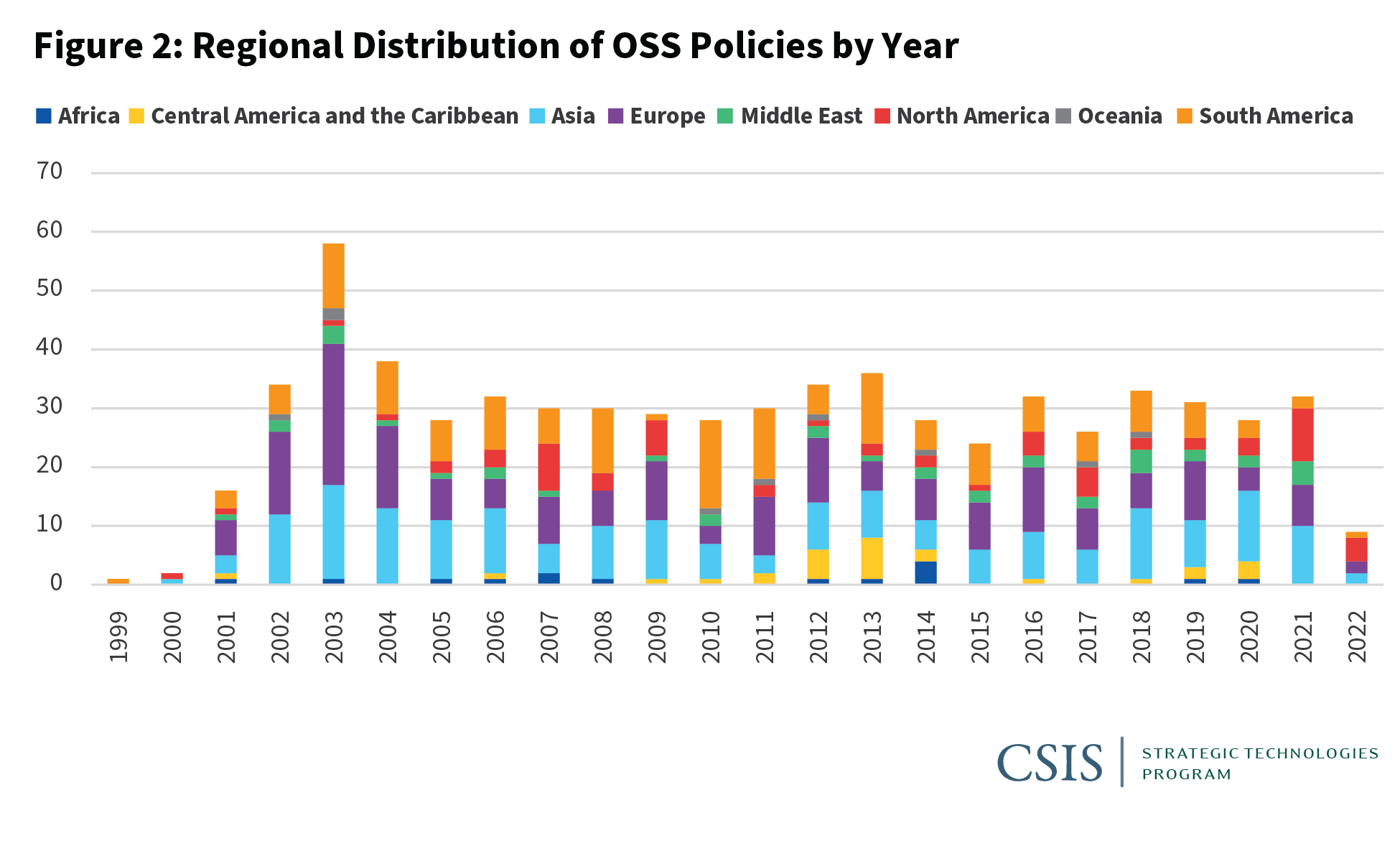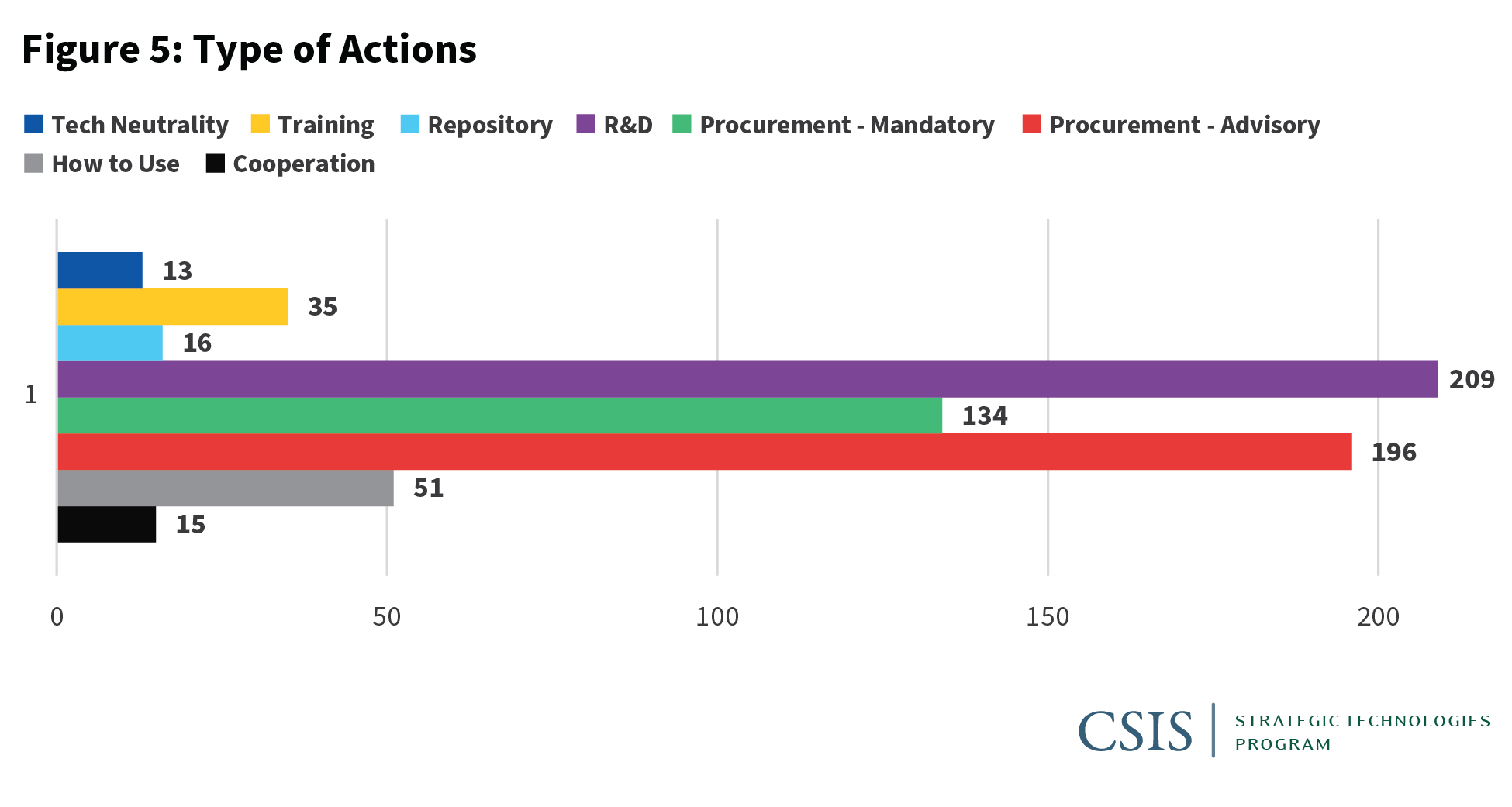Georgia Wood, Eugenia Lostri
The CSIS government policies on open source software (OSS) data set captures the different ways in which governments around the world have engaged with OSS. The research team relied on publicly available information to populate the data set. To capture a broad array of policies, researchers used unofficial translations. The research took place between January–August 2022; however, researchers have included some well-documented policies and bills that have been introduced since then.
This survey found a total of 669 open source policy initiatives between 1999 and 2022. After a sharp increase in OSS policies in 2003 (2003 remains the year with the most activity, with 58 initiatives), interest remains constant overall, with an average of 28 initiatives being considered in any given year.
Most of the policies introduced convey the government’s support for OSS. This support can take the form of statements of interest (e.g., Argentina has a stream of resolutions declaring different OSS conferences or encounters to be of parliamentary or legislative interest), government-sponsored programs (e.g., the Dutch Open Standards and Open Source Software program, designed to stimulate adoption of OSS by government agencies), and conferences (e.g., the series of OSS conferences that the Ministry of Technology and Communications of Oman co-organized between 2013 and 2021).
How Governments Promote OSS
There are several ways in which governments around the globe have attempted to promote OSS. Previous data sets focused on research activities and mandated, preferential, and advisory use of OSS. In this iteration, the research team divided the policies into eight categories, including mandated and advisory procurement decisions and research and development (R&D) policies, and added the creation of repositories (platforms where OSS solutions are released and made available to the public or other government offices), training for government officials and citizens, partnerships with the private sector, and guidelines for developing or transitioning to OSS solutions. The team also noted when policies explicitly mentioned a policy of technology neutrality for software acquisition.
Most of the activity, regardless of the issuing authority, remains directed at trying to transition from proprietary software to OSS. Procurement policies—without distinguishing between mandatory and advisory—are the most common. After 2013, mandatory procurement policies appear to be less popular, while advisory policies continue to be introduced at similar rates. R&D initiatives are also highly prevalent, demonstrating widespread governmental interest in either promoting the use of OSS directly or studying its potential benefits.
R&D initiatives remain more likely to be approved relative to procurement policies. Mandatory procurement policies have the highest failure rate. While this can be related to opposition to a forced transition to OSS, it is important to note that this can also be explained by looking at the issuing authority. Legislatures mostly focus on procurement policies (101 of 165 initiatives fall in the procurement category) and have an accessible record of legislative history that allows for consideration of all proposed, failed, and approved bills. The lack of visibility into proposed or failed actions from other authorities can skew these results.
Terminology
There are two terms that are usually used to define software code that can be freely accessed and distributed: OSS and Free/Libre and Open Source Software/Free and Open Source Software (FLOSS/FOSS). While both convey and apply to the same type of software, each emphasizes a different benefit: the former focuses on the technical aspects of the software, while the latter focuses on the liberties of this software.
This review of 669 policies shows that OSS is the most widely used term, accounting for 65 percent of the policies and initiatives. While the survey results must be considered in the context of incomplete or inaccessible information—in many cases, the research team had to rely on press releases in English that discussed policies drafted in another language or had to rely on unofficial translations—this percentage tracks how most of the OSS community is discussing the question at the international level.
However, understanding what each term conveys about the philosophy behind the policy is crucial to explaining why initiatives in South America overwhelmingly use “software libre,” with 134 out of 149 policies falling in the FLOSS/FOSS camp. It is also worth highlighting that the region has also adopted the term “public software”—software that is developed for and by the government and then made available to other offices and citizens. As the next section will discuss, South America has also focused on the link between FLOSS and sovereignty more than any other region.
Why OSS?
A new addition to the survey was the identification of each policy’s stated objective. As OSS initiatives evolve, the research team wanted to see if the underlying reason why governments would choose OSS over proprietary software changed. In this case, the team focused not only on the primary objective but on all the reasons stated in the policies themselves.
The team found that the main reason why governments sought to promote OSS was for modernization. The modernization category includes efforts at digitization, e-government, interoperability, and trainings to increase awareness and capacity. Support for national industry is the next most prevalent reason, with 20 percent of the policies falling in this category. In third place were initiatives that looked into the budgetary implications of OSS, with 18 percent of the policies advocating for solutions that would decrease the cost associated with acquiring and maintaining proprietary software without having to resort to pirated software. (For example, Cambodia’s Open Source Master Plan notes that Cambodia had to create an intellectual property law after joining the World Trade Organization, which made using proprietary software without a license illegal, making OSS a more attractive option.)
Related to this question is the matter of transparency. Eight percent of the policies explicitly identified the use of OSS by the government as a way to help increase transparency on how funds are used by the government and how procurement is secured. Especially in South America (although not limited to the region), the links between OSS and sovereignty are strong. Governments perceive OSS as a way to achieve technology sovereignty and autonomy—they seek to avoid dependency on foreign technology. Finally, in recent years more policies have started to focus on the security aspects of OSS solutions, and although it remains one of the smallest categories, the trend highlights security as a critical issue for policymakers looking at OSS.









No comments:
Post a Comment